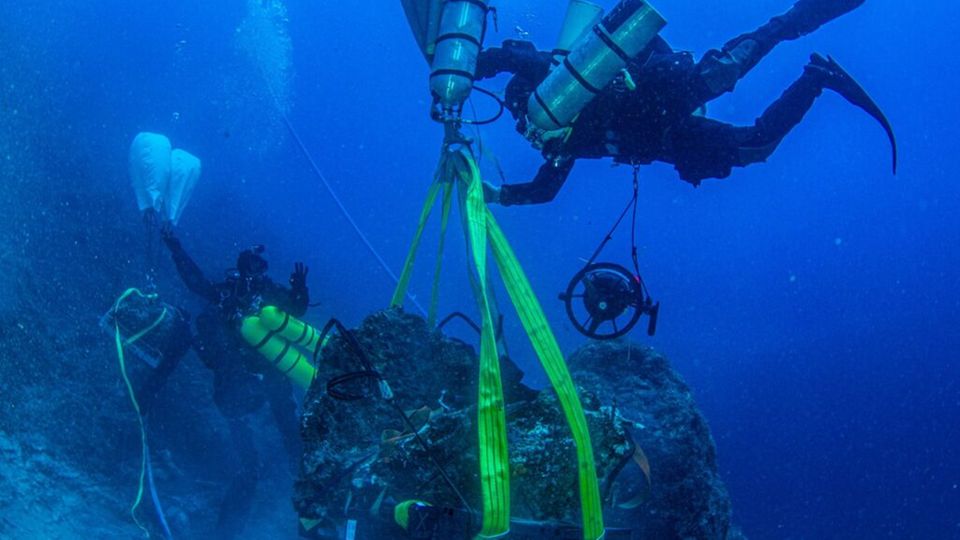Herculaneum
The volcanic eruption of Pompeii buried a huge library – now AI is saving the treasure trove of knowledge from ancient Rome
The heat of the volcanic eruption preserved the scrolls. But they can no longer be rolled out
© Digital Restoration Team at the University of Kentucky/Ves/ / Picture Alliance
When Vesuvius erupted in 79 AD, it didn’t just freeze Pompeii in time under its ashes. Huge quantities of rare scrolls were preserved in a nearby villa. With the help of AI, they are finally becoming readable.
It is one of the most famous tragedies of antiquity. The eruption of Mount Vesuvius nearly 2,000 years ago leveled the nearby city of Pompeii, burying it in lava and ash. And made them a treasure for archaeologists. A breakthrough with the help of AI could now help to uncover another huge wealth of knowledge.
It rests in the so-called Herculanese Paypri. The countless scrolls were from the same volcanic eruption in a villa near the also buried city Herculaneum damaged. They were only rediscovered in the 18th century. The problem: The heat has completely charred the rolls. But with the help of AI we have finally managed to decipher them.
Breakthrough by students
The three students Yousef Nader, Luke Farritor and Julian Schilliger achieved the biggest breakthrough to date. As part of a competition, they managed to read 15 blocks of text from one of the charred rolls and made over 85 percent of the characters recognizable. In total, they were able to decipher over 2,000 characters of text. To understand the extent of the achievement, one only has to remember the last breakthrough last autumn: that was the first time that letters had ever been read from the rolls – but only a single word.
The students’ submission exceeded all expectations of the “Vesuvius Challenge” announced last year. To qualify, participants had to make four blocks of text with at least 140 characters readable. Most of the participating teams thought the chances of this were rather poor. It was a corresponding surprise when the students even submitted eleven more blocks. Competition co-founder Nat Friedman exuberantly announced her victory. And with it the crowdfunded prize money of $700,000.

Old writings, modern technology
We owe the fact that competition is even possible to the advances in technology and artificial intelligence in recent years. The heat of the volcanic ash has charred the scrolls beyond recognition; they look more like burnt logs than documents.
The rolls are so fragile that they simply fall apart every time you try to open them. However, even careful opening would hardly help: writing is simply no longer visible. Even hundreds of years after the discovery of the approximately 800 scrolls that have been recovered so far, it was still a mystery what knowledge they contained.
Location by location
Brent Seales did the preparatory work. The computer scientist at the University of Kentucky has been trying to unravel the secrets of the documents for decades. Using medical devices for non-invasive analysis such as CT and ultrasound, he initially managed to analyze the rolls. With the help of computer programs specially written by him, he was finally able to digitally “unroll” them after years of precise work.
But then the next challenge came. The ink was also burnt in the heat. Then in August, a participant in the competition named Casey Handmer made the crucial discovery: a pattern of apparent creases in the paper that he had discovered in one of the CT scans actually turned out to be letters.
This then served as the basis for the competition winners. First, they examined the CT images with the naked eye for similar traces. Although the majority of the letters remained invisible, the examples found were enough to train a modern artificial intelligence. It was only their ability to recognize patterns that achieved what was previously impossible: the AI recognized the ink traces in the scans that were no longer visible to the human eye and thus also the remaining, previously invisible letters. The writing was deciphered.
Hope for more
The content of the role made so readable is in itself unspectacular. The author of the scroll, presumably the philosopher Philodemus according to Friedman, had written in Greek about food, dancing and the joys of everyday life. Nevertheless, the text raises high expectations: so far only five percent of the scroll has been deciphered. Above all, many more are still waiting to be deciphered.
Even the 800 rolls found so far could be just the beginning. Only a very small part of the villa, which is said to have once belonged to Julius Caesar’s father-in-law, has been excavated. It is said to have contained a huge library with thousands of documents. The hopes of some experts are correspondingly high. “Some of these texts could rewrite the history of entire time periods,” enthuses history professor Robert Fowler from the University of Bristol to “Bloomberg.”
More hurdles
However, retrieving them could be a challenge. In the 2,000 years after the eruption of Mount Vesuvius, the world continued to turn; Ercolano, a city with 50,000 inhabitants, emerged on the remains of Herculaneum. And they also built over the old villa. In order to recover all the treasures, houses would also have to be demolished.
But there is still enough work to be done with the recovered writings. After the success of the competition, Friedman now wants to move on to the next round. He wants to make 85 percent of the five percent readable font on the first roll. He continues to hope for the big find that will be worth all the effort. “Be it a dialogue by Aristotle or a poem by Homer. Or a report from a Roman general about this Jesus guy who is now supposed to be on the move.”
Sources: Vesivius Challenge, Nat Friedman, Bloomberg, The Herculaneum Society,Ars Technica


